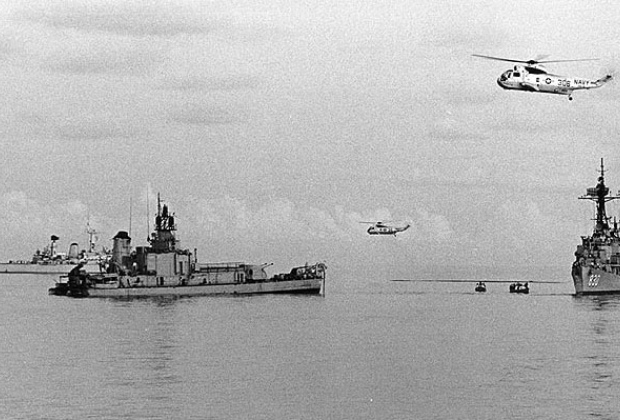Survivors recall collision of US, Australian ships during Vietnam War

On a calm, moonlit night 43 years ago in the South China Sea, Tom Anthony was a young radar man asleep in his metal bunk on the USS Frank E. Evans.
He was jarred awake after 3 a.m. by the horrendous sound of an Australian aircraft carrier crashing into the side of the destroyer.
The collision sent Anthony and shipmates scrambling through the dark as water poured into the compartment. As the ship rolled -- the bow section would sink in three to five minutes -- he reached a ceiling latch and looked back on a sight that would be seared into his mind forever.
"I saw the water rising real quick and I could see the suction," said Anthony, now 65, who lives in Mansfield. "And I saw some guys being sucked back down."
Decades later, that memory still reddens his eyes with tears. It is the sort of haunting image that brings Anthony and other survivors of the disaster that killed 74 U.S. sailors together each year for a reunion of the USS Frank E. Evans (DD 754).
This weekend, 16 of the 199 survivors, families of survivors and four sailors from the Australian carrier gathered at the Hyatt Regency at Dallas/Fort Worth Airport.
The annual gathering involves everything from a memorial service to a pub-crawl through the Fort Worth Stockyards.
"It's better therapy than you can get anywhere," said Pete Peters, 66, a survivor who traveled to the reunion from California. "These guys know because they were there when the collision happened. They know what we went through, and they understand.
"So we sit down and we drink a beer and talk about what happened."
The collision
The USS Frank E. Evans had provided gunfire support off the coast of Vietnam to fighting forces ashore before it was directed to leave the combat zone and join an operation with ships from nations in the Southeast Asia Treaty Organization. On June 3, 1969, it was performing night maneuvers with the HMAS Melbourne when miscommunication put the ships on a collision course.
The much larger carrier tore the destroyer in two.
Joe Mulitsch, a 19-year-old Navy firefighter, had just taken readings in the engine room and had one foot on a ladder when the ships collided.
"And all at once, the deck rose up, the lights went out, the steam was coming down and it flooded out," Mulitsch said. "You could hear the moaning and the crying from the guys on the upper level who all got extremely burned by the 950-degree steam. They were like lobsters."
Mulitsch found an inboard hatch in the darkened ship that allowed surviving sailors to escape, said Peters, who suffered first- and second-degree burns.
Confusion consumed the sailors as they fled. Some wondered whether they had run aground. Others believed it was a torpedo. Mulitsch estimates that he was less than 8 feet from the spot where the ship was cut in two.
"I was just really fortunate," he said. "Everybody I ate dinner with that night died."
Some sailors found that the latches leading to safety were jammed. Anthony grappled with a latch that wouldn't budge. A fellow sailor told him that they had to find another way out, but Anthony told him that it was too late: The water was already too high.
"I just started praying," he said. "This was my life, you know."
Suddenly, the latch popped open. Anthony saw the stars in the sky, and he made his way out.
The Australians
The Australian sailors on the Melbourne were just as stunned as the Americans. Ron Baker was in a radio shack when the collision occurred and first thought that the carrier had struck a Russian submarine that was monitoring the exercise.
He got outside just in time to see the bow section of the Frank Evans do a semicircle and plunge into the sea.
It was hectic and surreal. Australian sailors were running everywhere and jumping in the water trying to save Americans. Boats were lowered. Helicopters were launched. It went on like that until the surviving Americans were pulled onto the carrier.
Because it was the middle of the night, the American sailors were in underwear, even naked, he said. The Australian sailors gave them clothes from their own lockers.
"Then we broke open the beer store and issued them all with a couple of big cans of Foster beer," Baker said. "And we had the ship's band come up and play them American music just to take their mind off what had happened."
The news
Walter Cronkite announced news of the Frank Evans disaster to the nation.
But information from the military didn't travel quickly in 1969 and sailors' families were left to wonder whether their loved ones survived.
In Pomona, Calif., 22-year-old sailor Steve Kraus' wife, who was six months pregnant, waited days to learn whether her husband had survived.
Kraus did live. Swept off the ship by the rising water, he swam from the sinking wreckage until he was rescued.
Three days after the collision, a telegram informed his wife that he was alive.
On a farm in Niobrara, Neb., a family grieved for three brothers, Gary, 22, Gregory, 21, and Kelly Sage, 19. All three young men died on the destroyer.
Linda Sage Vaa, Gregory Sage's widow, attended the reunion. She said her husband's mother, Eunice, screamed and fainted when she turned on the television and heard a news announcer say that the Frank Evans had been cut in half.
When word came that none of the brothers survived, Vaa called a close girlfriend whose husband also served on the destroyer.
"My husband is dead," Vaa told her, tearfully.
"So is mine," her girlfriend cried.
The Wall
The names of the 74 fallen sailors do not appear on the Vietnam Veterans Memorial in Washington, D.C., because the collision occurred outside the designated combat area and the deaths were not the result of enemy fire.
The decision still upsets the survivors and the relatives of victims.
"That is something that irritates me to death to this day," Anthony said. "Why aren't they on The Wall?"
The Sage brothers' parents, Ernest and Eunice, have died, but it was their greatest wish to see their sons honored on The Wall, Vaa said.
"We never got their bodies; we never got anything," said Vaa, who remarried. "But if we could see their names on there, we will know their deaths were acknowledged."
Survivors and relatives have lobbied for years to add the names, said Joe Bob Mann, a 63-year-old survivor from Friona.
The fallen sailors are clearly casualties of the Vietnam War, survivors say.
"We had just come off the gun line. We got a commendation for what we did on the gun line," Mulitsch said.
"I mean, these are people who left and never came home. They're down there in 6,000 feet of water in the South China Sea.
"And it just seems like there ought to be some room for them."
———
©2012 the Fort Worth Star-Telegram
Distributed by MCT Information Services











